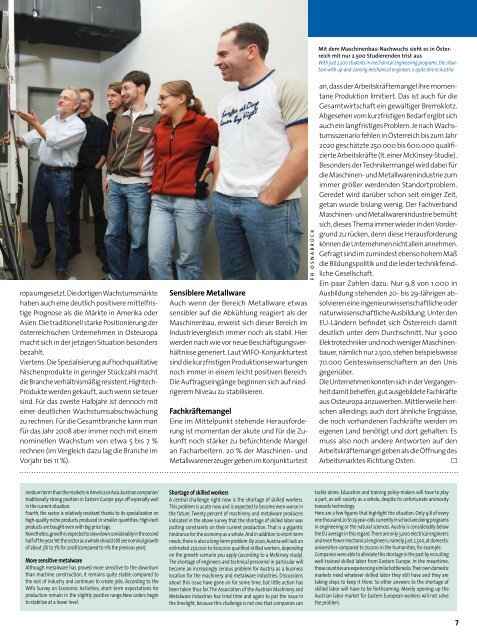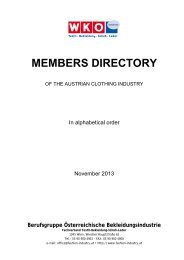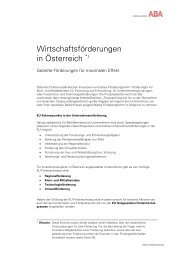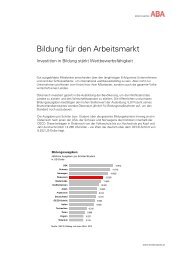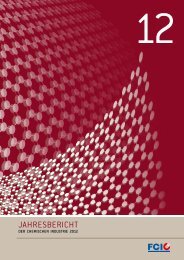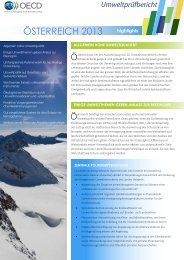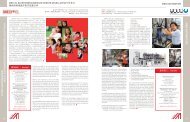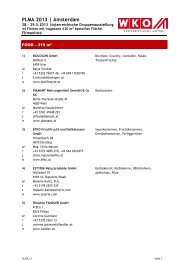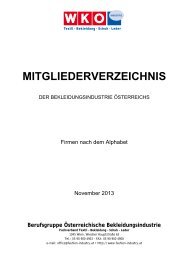Beschäftigungsmotor in unsicheren Zeiten - Advantage Austria
Beschäftigungsmotor in unsicheren Zeiten - Advantage Austria
Beschäftigungsmotor in unsicheren Zeiten - Advantage Austria
Sie wollen auch ein ePaper? Erhöhen Sie die Reichweite Ihrer Titel.
YUMPU macht aus Druck-PDFs automatisch weboptimierte ePaper, die Google liebt.
opa umgesetzt. Die dortigen Wachstumsmärkte<br />
haben auch e<strong>in</strong>e deutlich positivere mittelfristige<br />
Prognose als die Märkte <strong>in</strong> Amerika oder<br />
Asien. Die traditionell starke Positionierung der<br />
österreichischen Unternehmen <strong>in</strong> Osteuropa<br />
macht sich <strong>in</strong> der jetzigen Situation besonders<br />
bezahlt.<br />
Viertens: Die Spezialisierung auf hochqualitative<br />
Nischenprodukte <strong>in</strong> ger<strong>in</strong>ger Stückzahl macht<br />
die Branche verhältnismäßig resistent. Hightech-<br />
Produkte werden gekauft, auch wenn sie teuer<br />
s<strong>in</strong>d. Für das zweite Halbjahr ist dennoch mit<br />
e<strong>in</strong>er deutlichen Wachstumsabschwächung<br />
zu rechnen. Für die Gesamtbranche kann man<br />
für das Jahr 2008 aber immer noch mit e<strong>in</strong>em<br />
nom<strong>in</strong>ellen Wachstum von etwa 5 bis 7 %<br />
rechnen (im Vergleich dazu lag die Branche im<br />
Vorjahr bei 11 %).<br />
medium term than the markets <strong>in</strong> America or Asia. <strong>Austria</strong>n companies’<br />
traditionally strong position <strong>in</strong> Eastern Europe pays off especially well<br />
<strong>in</strong> the current situation.<br />
Fourth, the sector is relatively resistant thanks to its specialization on<br />
high-quality niche products produced <strong>in</strong> smaller quantities. High-tech<br />
products are bought even with big price tags.<br />
Nonetheless, growth is expected to slow down considerably <strong>in</strong> the second<br />
half of the year. Yet the sector as a whole should still see nom<strong>in</strong>al growth<br />
of about 5% to 7% for 2008 (compared to 11% the previous year).<br />
More sensitive metalware<br />
Although metalware has proved more sensitive to the downturn<br />
than mach<strong>in</strong>e construction, it rema<strong>in</strong>s quite stable compared to<br />
the rest of <strong>in</strong>dustry and cont<strong>in</strong>ues to create jobs. Accord<strong>in</strong>g to the<br />
Wifo Survey on Economic Activities, short term expectations for<br />
production rema<strong>in</strong> <strong>in</strong> the slightly positive range.New orders beg<strong>in</strong><br />
to stabilize at a lower level.<br />
sensiblere Metallware<br />
Auch wenn der Bereich Metallware etwas<br />
sensibler auf die Abkühlung reagiert als der<br />
Masch<strong>in</strong>enbau, erweist sich dieser Bereich im<br />
Industrievergleich immer noch als stabil. Hier<br />
werden nach wie vor neue Beschäftigungsverhältnisse<br />
generiert. Laut WIFO-Konjunkturtest<br />
s<strong>in</strong>d die kurzfristigen Produktionserwartungen<br />
noch immer <strong>in</strong> e<strong>in</strong>em leicht positiven Bereich.<br />
Die Auftragse<strong>in</strong>gänge beg<strong>in</strong>nen sich auf niedrigerem<br />
Niveau zu stabilisieren.<br />
Fachkräftemangel<br />
E<strong>in</strong>e im Mittelpunkt stehende Herausforderung<br />
ist momentan der akute und für die Zukunft<br />
noch stärker zu befürchtende Mangel<br />
an Facharbeitern. 20 % der Masch<strong>in</strong>en- und<br />
Metallwarenerzeuger geben im Konjunkturtest<br />
shortage of skilled workers<br />
A central challenge right now is the shortage of skilled workers.<br />
This problem is acute now and is expected to become even worse <strong>in</strong><br />
the future. Twenty percent of mach<strong>in</strong>ery and metalware producers<br />
<strong>in</strong>dicated <strong>in</strong> the above survey that the shortage of skilled labor was<br />
putt<strong>in</strong>g constra<strong>in</strong>ts on their current production. That is a gigantic<br />
h<strong>in</strong>drance for the economy as a whole. And <strong>in</strong> addition to short-term<br />
needs, there is also a long-term problem. By 2020, <strong>Austria</strong> will lack an<br />
estimated 250,000 to 600,000 qualified skilled workers, depend<strong>in</strong>g<br />
on the growth scenario you apply (accord<strong>in</strong>g to a McK<strong>in</strong>sey study).<br />
The shortage of eng<strong>in</strong>eers and technical personnel <strong>in</strong> particular will<br />
become an <strong>in</strong>creas<strong>in</strong>gly serious problem for <strong>Austria</strong> as a bus<strong>in</strong>ess<br />
location for the mach<strong>in</strong>ery and metalware <strong>in</strong>dustries. Discussions<br />
about this issue have gone on for some time, but little action has<br />
been taken thus far. The Association of the <strong>Austria</strong>n Mach<strong>in</strong>ery and<br />
Metalware Industries has tried time and aga<strong>in</strong> to put the issue <strong>in</strong><br />
the limelight, because this challenge is not one that companies can<br />
FH OSNABRüCK<br />
Mit dem Masch<strong>in</strong>enbau-Nachwuchs sieht es <strong>in</strong> Österreich<br />
mit nur 2.500 Studierenden trist aus<br />
With just 2,500 students <strong>in</strong> mechanical eng<strong>in</strong>eer<strong>in</strong>g programs, the situation<br />
with up-and-com<strong>in</strong>g mechanical eng<strong>in</strong>eers is quite dire <strong>in</strong> <strong>Austria</strong><br />
an, dass der Arbeitskräftemangel ihre momentane<br />
Produktion limitiert. Das ist auch für die<br />
Gesamtwirtschaft e<strong>in</strong> gewaltiger Bremsklotz.<br />
Abgesehen vom kurzfristigen Bedarf ergibt sich<br />
auch e<strong>in</strong> langfristiges Problem. Je nach Wachstumsszenario<br />
fehlen <strong>in</strong> Österreich bis zum Jahr<br />
2020 geschätzte 250.000 bis 600.000 qualifizierte<br />
Arbeitskräfte (lt. e<strong>in</strong>er McK<strong>in</strong>sey-Studie).<br />
Besonders der Technikermangel wird dabei für<br />
die Masch<strong>in</strong>en- und Metallwaren<strong>in</strong>dustrie zum<br />
immer größer werdenden Standortproblem.<br />
Geredet wird darüber schon seit e<strong>in</strong>iger Zeit,<br />
getan wurde bislang wenig. Der Fachverband<br />
Masch<strong>in</strong>en- und Metallwaren<strong>in</strong>dustrie bemüht<br />
sich, dieses Thema immer wieder <strong>in</strong> den Vordergrund<br />
zu rücken, denn diese Herausforderung<br />
können die Unternehmen nicht alle<strong>in</strong> annehmen.<br />
Gefragt s<strong>in</strong>d im zum<strong>in</strong>dest ebenso hohem Maß<br />
die Bildungspolitik und die leider technikfe<strong>in</strong>dliche<br />
Gesellschaft.<br />
E<strong>in</strong> paar Zahlen dazu: Nur 9,8 von 1.000 <strong>in</strong><br />
Ausbildung stehenden 20- bis 29-Jährigen absolvieren<br />
e<strong>in</strong>e <strong>in</strong>genieurwissenschaftliche oder<br />
naturwissenschaftliche Ausbildung. Unter den<br />
EU-Ländern bef<strong>in</strong>det sich Österreich damit<br />
deutlich unter dem Durchschnitt. Nur 3.000<br />
Elektrotechniker und noch weniger Masch<strong>in</strong>enbauer,<br />
nämlich nur 2.500, stehen beispielsweise<br />
70.000 Geisteswissenschaftern an den Unis<br />
gegenüber.<br />
Die Unternehmen konnten sich <strong>in</strong> der Vergangenheit<br />
damit behelfen, gut ausgebildete Fachkräfte<br />
aus Osteuropa anzuwerben. Mittlerweile herrschen<br />
allerd<strong>in</strong>gs auch dort ähnliche Engpässe,<br />
die noch vorhandenen Fachkräfte werden im<br />
eigenen Land benötigt und dort gehalten. Es<br />
muss also noch andere Antworten auf den<br />
Arbeitskräftemangel geben als die Öffnung des<br />
Arbeitsmarktes Richtung Osten. �<br />
tackle alone. Education and tra<strong>in</strong><strong>in</strong>g policy-makers will have to play<br />
a part, as will society as a whole, despite its unfortunate animosity<br />
towards technology.<br />
Here are a few figures that highlight the situation. Only 9.8 of every<br />
one thousand 20 to 29 year-olds currently <strong>in</strong> school are do<strong>in</strong>g programs<br />
<strong>in</strong> eng<strong>in</strong>eer<strong>in</strong>g or the natural sciences. <strong>Austria</strong> is considerably below<br />
the EU average <strong>in</strong> this regard. There are only 3,000 electrical eng<strong>in</strong>eers<br />
and even fewer mechanical eng<strong>in</strong>eers, namely, just 2,500, at domestic<br />
universities compared to 70,000 <strong>in</strong> the humanities, for example.<br />
Companies were able to alleviate this shortage <strong>in</strong> the past by recruit<strong>in</strong>g<br />
well-tra<strong>in</strong>ed skilled labor from Eastern Europe. In the meantime,<br />
those countries are experienc<strong>in</strong>g similar bottlenecks. Their own domestic<br />
markets need whatever skilled labor they still have and they are<br />
tak<strong>in</strong>g steps to keep it there. So other answers to the shortage of<br />
skilled labor will have to be forthcom<strong>in</strong>g. Merely open<strong>in</strong>g up the<br />
<strong>Austria</strong>n labor market for Eastern European workers will not solve<br />
the problem.<br />
7


